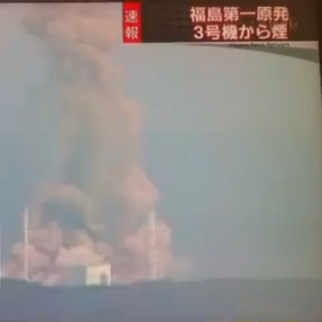Tokyo. .- A new explosion occurred today in the No. 2 reactor nuclear power plant in Fukushima, northeastern Japan, the third that originates in the same facilities after the earthquake on Friday. In addition, there has been a fire in the building that houses the reactor number 4 of the nuclear plant, which has already been extinguished.
The operator of the plant, TEPCO reported that in extinguishing the fire, caused by a buildup of hydrogen, U.S. Army troops participated, according to the Asahi newspaper's Web site. The fire in the reactor 4, which reported the Japanese government, joined the existing issues in reactors 1, 2 and 3 of the Fukushima No.
1 plant (Daiichi), which has caused three explosions on Saturday, because the impact of the devastating earthquake on Friday in Japan. The operating company, TEPCO, does not rule out mergers reactor core due to overheating. Today there was an explosion early in the structure that protects the Daiichi No.
2 reactor, the third since Saturday. Previously, the explosions occurred in the secondary containment of reactor number 1, Saturday, and the number 3, Sunday, without, as the Japanese government, due to hydrogen combustion. It is feared that the blast appeared to have affected the system of the reactor pressure control and that may have caused the leakage of an undetermined amount of radioactive material, according to the Nuclear Security Agency.
Kyodo news agency said the radiation levels "exceeded the legal limit" after the explosion to reach for a moment to microsievert 8127, eight times above the recommended ceiling for health. In the province of Ibaraki, southern Fukushima, also detected an increase in air ionization. According to the same source, the security enclosure which protects the heart may have been damaged by the pressure drop inside due to the combustion of hydrogen.
The blast occurred early in the morning, the 6.10 local time (21.10 GMT Monday), shortly after the Government conceded that the reactor was still unstable and, according to Kyodo news agency has begun evacuating employees from central . The plant operators were working overnight to inject salt water into the secondary containment of the reactor in an attempt to cool the core and prevent radioactive fusion.
The workers of this plant 40 years sought to keep intact the primary recipients of the reactor containment (the "layers" that protect them) and prevent a dangerous leak of radioactivity in the area, which has evacuated over 200,000 people . If the core began to melt, would cause an emergency emission of radiation.
The reactor at Fukushima No. 2 on Monday suffered a failure in one of the ten valves affecting the cooling system, similar to what happened before they exploded reactors 1 and 3 of the same plant after the earthquake of magnitude 9 on the Richter scale on Friday. The company operates in Fukushima acknowledged that fears a radiation leak from a possible meltdown of the reactor No.
2. Tokyo Electric Power (TEPCO) admitted that may have been emitted radiation after being damaged structure surrounding the reactor number 2. 


The operator of the plant, TEPCO reported that in extinguishing the fire, caused by a buildup of hydrogen, U.S. Army troops participated, according to the Asahi newspaper's Web site. The fire in the reactor 4, which reported the Japanese government, joined the existing issues in reactors 1, 2 and 3 of the Fukushima No.
1 plant (Daiichi), which has caused three explosions on Saturday, because the impact of the devastating earthquake on Friday in Japan. The operating company, TEPCO, does not rule out mergers reactor core due to overheating. Today there was an explosion early in the structure that protects the Daiichi No.
2 reactor, the third since Saturday. Previously, the explosions occurred in the secondary containment of reactor number 1, Saturday, and the number 3, Sunday, without, as the Japanese government, due to hydrogen combustion. It is feared that the blast appeared to have affected the system of the reactor pressure control and that may have caused the leakage of an undetermined amount of radioactive material, according to the Nuclear Security Agency.
Kyodo news agency said the radiation levels "exceeded the legal limit" after the explosion to reach for a moment to microsievert 8127, eight times above the recommended ceiling for health. In the province of Ibaraki, southern Fukushima, also detected an increase in air ionization. According to the same source, the security enclosure which protects the heart may have been damaged by the pressure drop inside due to the combustion of hydrogen.
The blast occurred early in the morning, the 6.10 local time (21.10 GMT Monday), shortly after the Government conceded that the reactor was still unstable and, according to Kyodo news agency has begun evacuating employees from central . The plant operators were working overnight to inject salt water into the secondary containment of the reactor in an attempt to cool the core and prevent radioactive fusion.
The workers of this plant 40 years sought to keep intact the primary recipients of the reactor containment (the "layers" that protect them) and prevent a dangerous leak of radioactivity in the area, which has evacuated over 200,000 people . If the core began to melt, would cause an emergency emission of radiation.
The reactor at Fukushima No. 2 on Monday suffered a failure in one of the ten valves affecting the cooling system, similar to what happened before they exploded reactors 1 and 3 of the same plant after the earthquake of magnitude 9 on the Richter scale on Friday. The company operates in Fukushima acknowledged that fears a radiation leak from a possible meltdown of the reactor No.
2. Tokyo Electric Power (TEPCO) admitted that may have been emitted radiation after being damaged structure surrounding the reactor number 2.

No comments:
Post a Comment